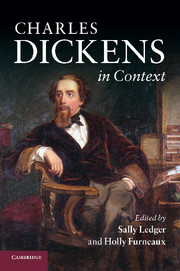Book contents
- Frontmatter
- Contents
- List of illustrations
- Notes on contributors
- Preface
- Notes on references
- PART I LIFE AND AFTERLIFE
- PART II SOCIAL AND CULTURAL CONTEXTS
- 12 Popular culture
- 13 The rise of celebrity culture
- 14 The newspaper and periodical market
- 15 Authorship and the professional writer
- 16 The theatre
- 17 Melodrama
- 18 The Bildungsroman
- 19 Visual culture
- 20 The historical novel
- 21 The illustrated novel
- 22 Christmas
- 23 Childhood
- 24 Work
- 25 Europe
- 26 The Victorians and America
- 27 Educating the Victorians
- 28 London
- 29 Politics
- 30 Political economy
- 31 The aristocracy
- 32 The middle classes
- 33 Urban migration and mobility
- 34 Financial markets and the banking system
- 35 Empires and colonies
- 36 Race
- 37 Crime
- 38 The law
- 39 Religion
- 40 Science
- 41 Transport
- 42 Illness, disease and social hygiene
- 43 Domesticity
- 44 Sexuality
- 45 Gender identities
- Further reading
- Index
14 - The newspaper and periodical market
Published online by Cambridge University Press: 05 August 2012
- Frontmatter
- Contents
- List of illustrations
- Notes on contributors
- Preface
- Notes on references
- PART I LIFE AND AFTERLIFE
- PART II SOCIAL AND CULTURAL CONTEXTS
- 12 Popular culture
- 13 The rise of celebrity culture
- 14 The newspaper and periodical market
- 15 Authorship and the professional writer
- 16 The theatre
- 17 Melodrama
- 18 The Bildungsroman
- 19 Visual culture
- 20 The historical novel
- 21 The illustrated novel
- 22 Christmas
- 23 Childhood
- 24 Work
- 25 Europe
- 26 The Victorians and America
- 27 Educating the Victorians
- 28 London
- 29 Politics
- 30 Political economy
- 31 The aristocracy
- 32 The middle classes
- 33 Urban migration and mobility
- 34 Financial markets and the banking system
- 35 Empires and colonies
- 36 Race
- 37 Crime
- 38 The law
- 39 Religion
- 40 Science
- 41 Transport
- 42 Illness, disease and social hygiene
- 43 Domesticity
- 44 Sexuality
- 45 Gender identities
- Further reading
- Index
Summary
As the House of Commons census returns show, the population of Great Britain and Ireland quadrupled between 1801 and 1901, from something over 10 to 41 million inhabitants. That of the British Empire, through acquisition of new territories, reached 400 million. As populations expanded at unprecedented rates, so too did levels of adult literacy. From 1836, the Registrar-General's returns showed increasing numbers of men and women signing rather than marking the marriage register: 66.4 per cent and 49.7 per cent respectively in England and Wales in 1840, rising to 80.2 per cent and 72.7 per cent in England by 1870, the year of Dickens's death. Furthermore, the innovative commercialisation of cheap fiction meant that prices fell consistently through the century: ‘[a] penny would buy a 250-word broadside in the 1840s, a fifty-page songbook or a 7,000-word serial by the 1860s, a 20,000-word novelette by the 1880s, and from 1896 … unabridged versions of classic texts’. However, while the number of customers for reading material clearly grew exponentially, the growth of the newspaper and periodical market did not simply shadow the graph, but was complicated if not constrained by numerous external factors.
Periodic economic crises and slumps affected the publishing industry in 1825–6, 1831 and 1841–3: circulations tottered, magazines, papers and publishing houses folded. Technological advances, whether in press design or steam locomotion, could accelerate print runs and national distribution, but as critics of the orthodox ‘Whig’ approach to press history point out, the mid-century industrialisation of the press increased start-up and fixed costs to the point where small enterprises, radical, evangelical or otherwise, were priced out of the market.
- Type
- Chapter
- Information
- Charles Dickens in Context , pp. 109 - 116Publisher: Cambridge University PressPrint publication year: 2011



